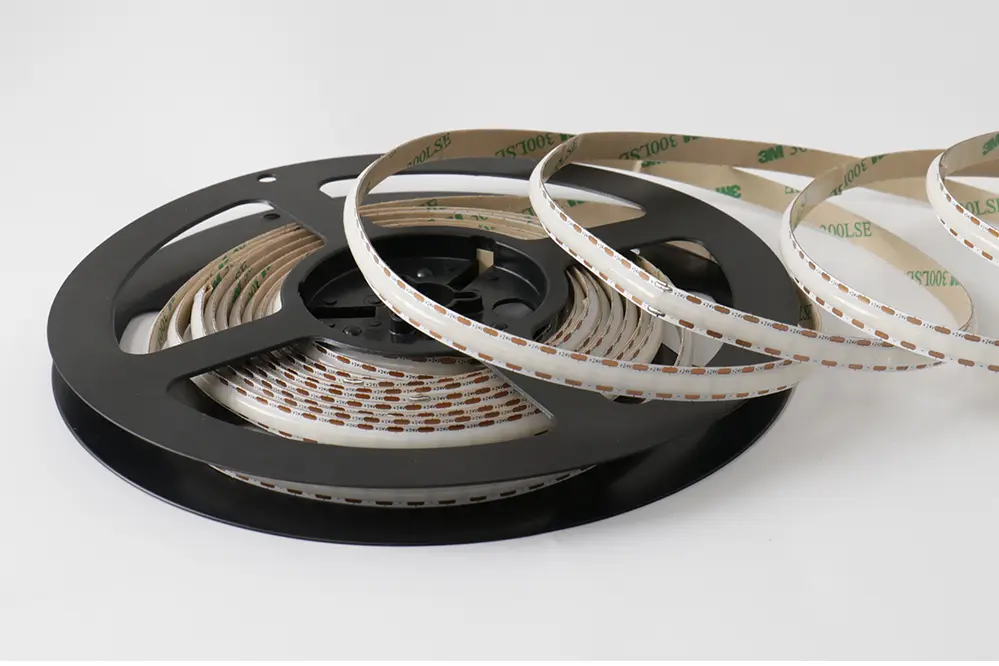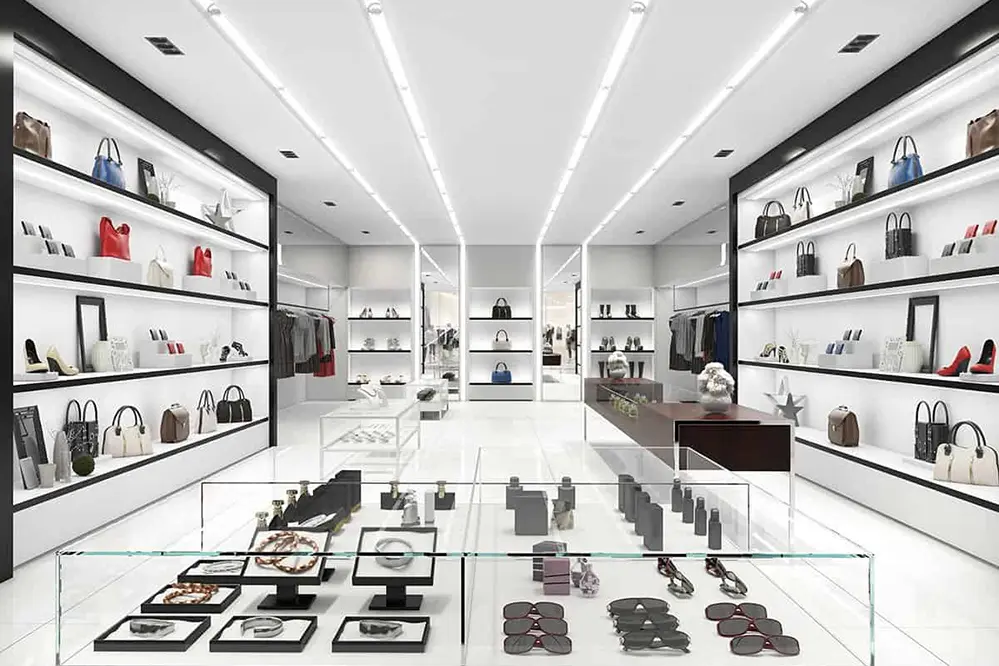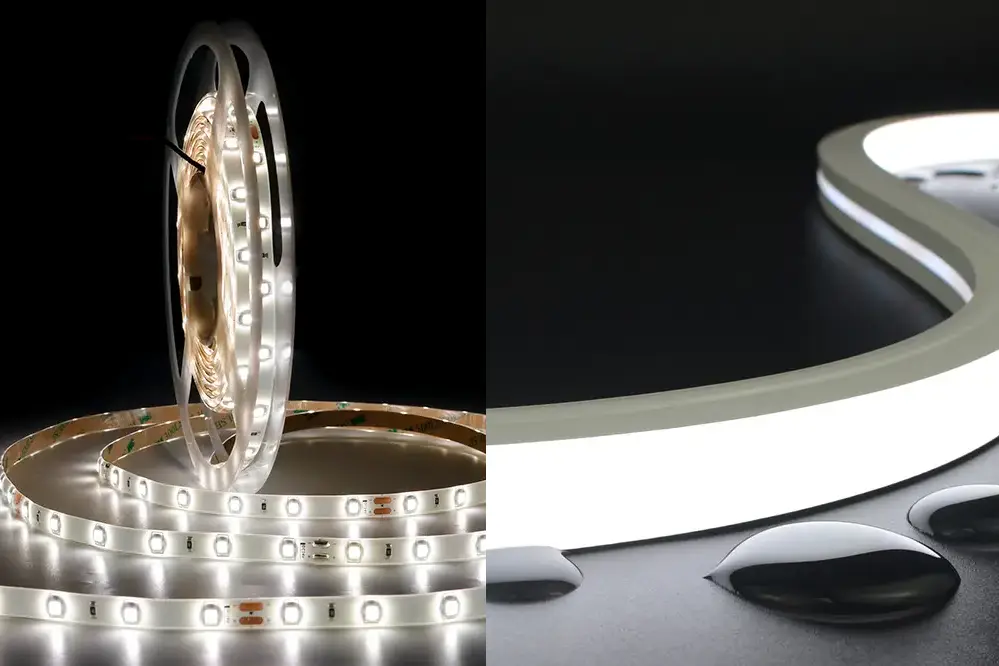In the ever-evolving world of lighting technology, choosing the right type of illumination can make all the difference. Among the most popular options today are LED strip lights, LED neon strips/LED neon lights. Both offer unique advantages and can transform spaces with their vibrant, energy-efficient glow. But when it comes to selecting the best option for your specific needs, the decision isn’t always straightforward. This blog post aims to dissect the differences between LED strip lights and LED neon strips, helping you make an informed choice.
LED strip lights have long been a favorite for their versatility and ease of installation. They can be used in a variety of settings, from accent lighting in homes to dynamic displays in commercial spaces. On the other hand, LED neon strips and led neon lights bring a different aesthetic to the table, offering a continuous, smooth light that mimics traditional neon but with the benefits of LED technology. Understanding the nuances between these two lighting solutions is crucial for anyone looking to enhance their environment with the perfect lighting.
As someone who has been immersed in the LED lighting industry since 2005, I, Tom, bring a wealth of experience and knowledge to this discussion. Over the years, I’ve witnessed the remarkable advancements in LED technology and have developed a keen understanding of its applications, particularly in LED strip lights. This blog post is a culmination of my extensive research and hands-on experience, aimed at providing you with the most accurate and helpful information.
So, whether you’re a lighting enthusiast or a professional seeking the best lighting solution, you’re in the right place. Let’s dive right in and explore the fascinating world of LED strip lights and LED neon strips!
Introduction to LED Strip Lights

In recent years, LED strip lights have increasingly captured attention, transforming spaces with their adaptability and creative potential. Their ease of use and energy efficiency makes them a preferred choice.
Many have seen the benefits they offer in dynamic lighting design.
Each strip consists of multiple LED bulbs, attached to a flexible circuit board, allowing for various applications. Whether used for accenting architectural features or lighting up workspaces, their versatility is unmatched.
Cuttable to custom lengths and available in myriad colors, they cater to personalized design needs. Premium models even offer sophisticated control options, enabling intricate lighting scenarios.
Furthermore, their low heat emission and long lifespan contribute to sustainable living, making them eco-friendly. Consuming less power while providing brilliant illumination aligns with contemporary standards.
Ultimately, the rise of LED strip lights is a testament to innovative, efficient, and stylish lighting solutions. They serve not only as functional light sources but as tools to elevate aesthetic appeal in any environment.
Introduction to LED Neon Strips

LED neon strips represent an evolution in lighting technology, offering a modern twist on traditional neon.
These strips combine the advantages of LEDs with the aesthetic qualities of classic neon tubes.
Introduced around 2016, LED neon strips feature LEDs enclosed in a silicone or PVC housing, mimicking the uniform glow of neon.
Furthermore, their flexibility and low voltage operation make them safer and easier to install, even in intricate designs.
LED neon strips bring a vibrant, continuous light that captures attention and enhances any setting.
LED Strip Light vs. LED Neon Strip: Key Differences
When comparing LED strip lights to LED neon strips, several key differences emerge, each catering to distinct applications and preferences.
Firstly, LED strip lights offer a versatile lighting solution with their thin, flexible PCB designs. These strips feature closely spaced LEDs, making them ideal for task lighting, accent lighting, and intricate installations requiring subtle illumination. Their simplicity in installation and lower cost make them accessible for a broad range of projects.
Conversely, LED neon strips or LED neon lights, stand out for their robust construction and distinctive uniform, diffused light. Encased in durable silicone or PVC, these strips provide an uninterrupted glow, akin to traditional neon lights but with greater efficiency and safety. This makes them particularly suitable for outdoor use, signage, and architectural accents where visual impact is paramount.
On balance, the choice between LED strip lights and LED neon strips depends on the specific requirements of the project. For applications needing precision and flexibility with minimal costs, LED strip lights are unparalleled. Meanwhile, LED neon strips excel in scenarios where durability and a striking visual presence are essential, ensuring a standout performance in both practicality and aesthetic finesse.
Brightness and Luminosity
In the realm of illumination, brightness and luminosity play critical roles in determining the efficacy and appeal of lighting solutions.
LED strip lights generally offer a high level of luminance, making them excellent for task lighting, accent lighting, and intricate installations. Their compact design allows for close-quarters applications where bright, direct lighting is needed to enhance functional visibility. The straightforward nature of these lights ensures that their intensity can be fine-tuned to meet a variety of project requirements.
Comparatively, LED neon strips deliver a different kind of brightness. Encased in diffusing materials, they emit a consistent, soft glow that mimics traditional neon lighting. This diffused light is often more aesthetically pleasing and provides an ambient brilliance rather than harsh, direct illumination.
Ultimately, the choice between LED strip lights and LED neon strips hinges on the intended lighting effect. Those seeking adjustable brightness and direct light for functional or intricate projects will find LED strip lights invaluable. In contrast, LED neon strips cater to projects where a smooth, luminous glow is paramount, offering elevated visual impact and enduring appeal.
Flexibility and Versatility
Flexibility and versatility stand as crucial factors when comparing the adaptability of LED strip lights and LED neon strips.
LED strip lights are renowned for their malleability, lending themselves to being bent and curved around various surfaces. This flexible nature makes them ideal for a multitude of applications, including under-cabinet lighting and accent features.
By contrast, LED neon strips, along with led neon rope lights, offer enhanced structural flexibility combined with resilience. They are often used in signage and decorative outlines where a consistent, rounded illumination is essential. Their bendable design ensures they can conform to more elaborate and precise installations.
For creative projects demanding intricate patterns, LED neon strips provide a superior edge. Their capability to maintain uniform brightness even when shaped into complex designs makes them highly desirable.
Ultimately, flexibility and versatility tip the scales toward LED neon strips for artistic or signage applications, while LED strip lights cater to more conventional, functional uses.
Installation Process
The installation of LED strip lights is straightforward and user-friendly. Most models come with adhesive backing, allowing for easy attachment to surfaces.
Preparation involves cleaning the surface for optimal adhesion. Additional tools, such as plastic clips or channels, may enhance stability.
LED neon strips, on the other hand, require a more intricate setup. While they do have adhesive backing, they often necessitate mounting channels for added support, ensuring the strips remain firmly in place despite being manipulated into complex shapes.
Moreover, connecting both types to a power source involves similar steps of ensuring proper voltage and wiring. However, LED neon strips can demand more precise control settings to achieve the desired illumination effects. This is a small price to pay for their impressive decorative capabilities.
Durability and Lifespan
When discussing durability and lifespan, both LED strip lights and LED neon strips present robust solutions for various applications, but some distinctions can be noted.
LED strip lights typically exhibit excellent durability due to their solid-state components.
These components ensure fewer moving parts, which translates to lower risks of damage over prolonged usage. Additionally, advancements in technology have fortified their design against common wear and tear, enhancing their service life significantly.
On the other hand, LED neon strips are designed to emulate traditional neon lights while offering remarkable resilience. Often encased in a flexible silicone or PVC housing, these strips demonstrate superior resistance against environmental factors like moisture, UV rays, and physical impact. This additional protection not only extends their operational lifespan but also ensures they remain an excellent choice for outdoor and intricate indoor applications.
Energy Efficiency
When evaluating energy efficiency, both LED strip lights and LED neon strips excel in minimizing energy consumption while maximizing illumination output.
LED strip lights, in particular, are renowned for their superb energy efficiency. They use advanced light-emitting diodes that convert a greater portion of electrical energy into light, resulting in significant energy savings over extended periods. Their low power consumption translates to lower electricity bills and reduced carbon footprints, making them an eco-friendly option.
Conversely, LED neon strips also boast impressive energy efficiency. These strips utilize similar LED technology but are optimized to mimic traditional neon’s visual appeal. Despite their elaborate design, they consume relatively low amounts of power, making them a striking yet sustainable lighting choice for various applications.
Both lighting solutions offer commendable energy efficiency, but the best choice for an application might depend on additional factors like aesthetic preferences or specific usage contexts. Ultimately, the shift toward either LED strip lights or LED neon strips represents a move toward more sustainable and energy-efficient lighting solutions, underscoring their pivotal role in contemporary lighting design.
Aesthetic Appeal
Both LED strip lights and LED neon strips offer distinct aesthetic advantages.
In terms of flexibility, LED strip lights excel in adaptability. They can easily bend around corners and fit into tight spaces, offering significant versatility in design choices.
Conversely, LED neon strips provide a smoother, more continuous line of light, closely resembling traditional neon. This makes them ideal for applications where a uniform glow is desired.
When deciding between the two, consider the intended atmosphere. LED strip lights can create varied effects, while LED neon strips excel in delivering a polished, uninterrupted glow.
Overall, each type offers a unique visual impact that can drastically transform spaces.
Cost Comparison
Assessing the costs is crucial.
At first glance, LED strip lights are generally more affordable. Their price point makes them an attractive option for those on tighter budgets, while still providing excellent functionality and energy efficiency. Installation costs are also generally lower, thanks to their lightweight design and ease of application.
LED neon strips, however, tend to come at a higher price.
The additional investment in LED neon strips often equates to higher durability and a longer lifespan, which can yield cost savings in the long term. Additionally, their robust construction can withstand harsher conditions, reducing replacement and maintenance expenses.
Thus, the choice between LED strip lights and LED neon strips might largely depend on the importance of upfront cost versus long-term savings. While LED strip lights are cost-effective initially, LED neon strips may offer greater financial benefits over an extended period due to their durability and lower maintenance needs.
Common Applications
LED strip lights thrive in under-cabinet lighting setups, adding functional elegance to kitchens and workspaces.
In retail settings, their dynamic and customizable color options (RGB) are perfect for creating eye-catching displays, while also being invaluable for accentuating architectural details and artwork.
LED neon strips’ flexibility and vibrant glow make them ideal for outdoor signage and custom art installations.
Residential Use

LED strip lights and LED neon strips both offer distinct advantages for residential lighting. The choice can significantly enhance a home’s ambiance and functional aesthetics.
LED strip lights can emit up to 16 million colors, making them perfect for mood lighting.
LED strip lights are incredibly versatile, fitting seamlessly under cabinets, along stairways, or as accent lighting behind furniture. They are cost-effective, easy to install, and can be customized to complement any interior decor.
On the other hand, LED neon strips provide a sleek, continuous line of light, ideal for creating modern and stylish spaces. Their durability and water resistance make them suitable for both indoor and outdoor use, offering homeowners a variety of creative lighting solutions.
Commercial Use

For commercial use, LED strip lights and LED neon strips serve different, yet equally valuable purposes.
- LED Strip Lights excel in retail environments.
- LED Neon Strips offer excellent visibility for signage.
- Energy Efficiency reduces operational costs for businesses.
- Customization Options cater to branding and thematic needs.
- Durability ensures long-lasting performance.
LED strip lights can be easily integrated into shelves and displays to highlight products.
LED neon strips provide a bold and engaging way to attract customers with vibrant, eye-catching signs.
Pros and Cons of LED Strip Lights
LED strip lights offer a multitude of benefits, especially for those looking to enhance their spaces creatively.
One of the key advantages is their flexibility and ease of installation. These characteristics make them an attractive option for DIY projects.
Moreover, LED strip lights are known for their energy efficiency, which translates into lower utility bills and a reduced carbon footprint. They also offer a wide range of colors and brightness levels.
However, it’s important to note that LED strip lights may not provide uniform lighting. This can be a drawback in settings where consistent illumination is crucial, such as workspaces or commercial environments.
In summary, LED strip lights are versatile and energy-efficient but may fall short in applications requiring even light distribution.
Pros and Cons of LED Neon Strips
LED neon strips, unlike traditional neon, offer flexibility and durability that make them ideal for various applications.
One significant advantage of LED neon strips is their ability to provide uniform and bright illumination, which makes them especially effective for signage and decorative purposes. These strips are also typically water-resistant, offering a layer of protection that extends their usability to outdoor settings and harsh environments.
Conversely, LED neon strips can come with a higher price tag compared to other lighting options. For some, this initial investment might be a stumbling block, despite the long-term benefits of durability and energy efficiency that these strips bring to the table.
Ultimately, choosing LED neon strips means opting for a lighting solution that combines visual appeal with robustness. Their uniform lighting, outdoor resilience, and overall aesthetic make them a strong contender for those seeking to make a striking visual impact, outweighing any initial cost concerns with their lasting benefits.
Final Verdict: Which is Better?
Choosing between LED strip lights and LED neon strips depends on specific needs and preferences. LED strip lights are ideal for budget-conscious projects, while LED neon strips offer uniform illumination and outdoor durability. The best choice hinges on the intended application, aesthetic goals, and environmental factors, allowing individuals and businesses to select the perfect lighting solution for their vision and requirements.
If you’re looking for expert guidance and high-quality products, consider reaching out to Unitop, a professional Chinese manufacturer specializing in LED strip lights and LED neon strips. With their extensive experience and commitment to excellence, Unitop can provide tailored solutions to meet your specific lighting needs. Whether you’re a homeowner looking to enhance your living space or a business aiming to create a captivating display, Unitop’s expertise and top-notch products ensure you achieve the perfect lighting outcome. Don’t hesitate to contact Unitop for all your LED lighting requirements.





